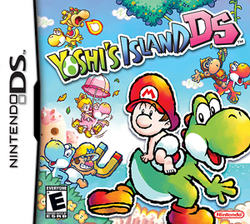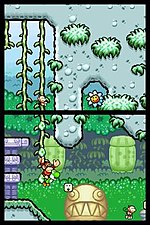This is an old revision of this page, as edited by Abryn (talk | contribs) at 21:53, 5 August 2009 (We need a better source than Nintendojo.). The present address (URL) is a permanent link to this revision, which may differ significantly from the current revision.
Revision as of 21:53, 5 August 2009 by Abryn (talk | contribs) (We need a better source than Nintendojo.)(diff) ← Previous revision | Latest revision (diff) | Newer revision → (diff) Video game| Yoshi's Island DS | |
|---|---|
 | |
| Developer(s) | Artoon |
| Publisher(s) | Nintendo |
| Series | Yoshi, Mario |
| Engine | Yoshi's Island: Super Mario Advance 3 engine |
| Platform(s) | Nintendo DS |
| Genre(s) | Platformer |
| Mode(s) | Single player |
Yoshi's Island DS (ヨッシー アイランド DS) is a platforming video game developed by Artoon for the Nintendo DS. Published by Nintendo, it was released in North America and Australasia in November 2006, in Europe in December 2006, and in Japan in March 2007. Announced at Nintendo's E3 press conference in May 2006, the game was well received by critics, scoring an average of 83% on Metacritic's aggregate. During development it was originally going to be titled Yoshi's Island 2 until two weeks before its US launch.
The game's story focuses on the Yoshi clan as they attempt to rescue newborn children that have been kidnapped by Kamek. Yoshi's Island DS uses the updated graphical style from Yoshi Touch & Go but retains the same core gameplay as its Super Nintendo Entertainment System predecessor, but whereas the SNES game featured only Baby Mario, DS introduces Baby Peach, Baby DK and Baby Wario and lets the player control Baby Bowser (who was a boss in SMW2), who each give Yoshi a different ability. The aim of the game is to use these abilities to progress through various themed worlds.
Gameplay

Yoshi's Island DS's gameplay is the same as the previous game, with some additions. The player guides various different colored Yoshis through side scrolling stages. Yoshi can jump and hover (flutter kick) for a short time, eat enemies and turn them into eggs (which can be used for things like hitting switches and defeating distant enemies) and pound the ground (to smash crates, for example). Some stages offer Yoshi the ability to morph into vehicles for a short time. DS, like the original Yoshi's Island, differs from many platforming games in that Yoshi does not have a life bar; when Yoshi is hit, the baby he is carrying falls off his back and Yoshi must retrieve him/her before a timer runs out.
DS differs from the previous game in that five babies are available for Yoshi to carry, each bestowing a different ability. Baby Mario allows Yoshi to dash and makes special 'M' blocks appear. He can also grab Super Stars to become Super Baby Mario. Baby Peach allows Yoshi to float and fly on wind currents, Baby DK can grab and swing on vines and ropes, Baby Wario uses his magnet to attract metal objects and Baby Bowser spits fireballs but this means the Yoshi carrying him cannot make eggs. The need to switch babies at key points adds a puzzle element to the game.
The Nintendo DS's two screens act as one tall screen. However, in practice, this essentially just gives the player a better view of the surroundings and, save for one boss battle (Hector the Reflector, where the bottom screen acts as a mirror through which to see Hector during the battle), only provides the benefit of being able to see more (above) and, when the player is on the top screen, below. The game does not make use of the bottom screen's touch sensitivity for basic gameplay, though it is an option for selecting levels and in some mini-games. Each of DS's five worlds has two bosses, each with a weakness that must be identified and exploited. Most of the time, these are simply giant-sized versions of normal enemies, though some are more inventive.
Flowers and coins, as well as stars, are scattered about the game's stages. These are totalled at the end of each stage and a score is given depending how many of each were collected (a maximum of 30 stars, 20 red coins and 5 flowers). Sufficiently high scores are required to unlock one of the two sets of secret levels (the other set being unlocked upon completing the game). Special character coins are also introduced. Missing from the game are the power-ups of sorts, like the ability to spit seeds by eating watermelons, which were present in the original.
Keys scattered throughout the stages unlock minigames, and also doors in the levels that would be closed otherwise.
Plot
As in Super Mario World 2: Yoshi's Island, Baby Mario and the Yoshi clan must rescue Baby Luigi, who was snatched by Bowser's minion, Kamek. However, this time the Yoshis have the combined assistance of both Baby Peach and Baby DK, who escaped the botched capture by the Magikoopa. They later join with Baby Wario and Baby Bowser, who offer their specialised abilities so that the group may proceed. Baby Wario's lust for treasure leads him to abandon his duties whilst Baby Bowser betrays the group upon arrival at Bowser's castle. Despite this, the babies and Yoshis prevail, in both defeating Bowser—who had traveled to the past to capture the "Star Babies"—and retrieving Baby Luigi.
Development
Yoshi's Island DS was announced at E3 2006 under the name Yoshi's Island 2, originally featuring only baby versions of Mario, Peach, and DK. The developer, Artoon, has made one other Yoshi game: Yoshi Topsy-Turvy for the GBA. Topsy-Turvy veered away from the "Nintendo" design, but for DS Artoon stuck close to the original concept.
The game retains the "classic" pastel/crayon visuals from its predecessor. Small changes are noticeable—water animation is better, the black outlines around objects aren't as thick and the backgrounds are less cluttered—but the visuals are still "tightly centered" on those of the Super NES game.
Reception
Yoshi's Island DS's reception was positive, being given high scores by some of the most prominent video game critics. These include gaming websites IGN and GameSpot, who gave it 8/10 and 9.1/10 respectively. GameSpot's review commented that the developers have "produced a sequel that seems fresh and new while remaining every bit as awesome as the original". Multimedia website IGN called it "a solid recreation of the Yoshi's Island elements in a two-screen-high format," and GamePro in their review said that "it's fun and light-hearted play". Reviewers were particularly pleased with how the core gameplay elements are the same as in the previous game. GamePro hails it as having "the classical 2D side-scrolling action and colorful pastel artwork that brought Nintendo to prominence", while IGN, although impressed with the game in general, wonders whether the developers "stuck too close to the established design in this new game", because having played the previous game "ruins a lot of the surprises". Other critics regard this as the best portable Yoshi's Island game (with the exception of the Super Mario Advance remake of the original Yoshi's Island) because in their context, "(Yoshi) Topsy-Turvy was not there and (Yoshi) Touch & Go was incomplete."
One problem critics identified is the blind spot created by the gap between the Nintendo DS's two screens. IGN accepts that this blind spot is necessary for aiming eggs properly but still describe it as "bothersome". GameSpy's reviewer calls it "a pain" and expresses frustration at being hit by an enemy hiding in this gap. On the whole, reviewers were pleased with the way the extra babies have been implemented, but IGN felt that Baby Wario was "a last minute addition that wasn't tested properly". They call his magnet "wonky", and says it "misses items that are right next to him".
Yoshi's Island DS was given GameSpot's "Editor's Choice" rating, and reached the final round for "Best Nintendo DS game". The game sold more than 300,000 copies in its first week of release in Japan. As of March 31, 2008, Yoshi's Island DS has sold 2.91 million copies worldwide.
References
- "Yoshi's Island DS". GameSpot. Retrieved 2007-08-14.
- ^ Harris, Craig (2006-05-09). "Return to Yoshi's Island". IGN. Retrieved 2006-11-25.
- "Yoshi's Island DS Reviews". Metacritic. Retrieved 2006-11-25.
- ^ Provo, Frank (2006-11-14). "Yoshi's Island DS Review". GameSpot. Retrieved 2006-11-25.
- ^ "Review: Yoshi's Island DS". GamePro. 2006-11-14. Retrieved 2006-11-25.
- ^ Harris, Craig (2006-11-13). "Yoshi's Island DS Review". IGN. Retrieved 2006-11-25.
- TheoBald, Phil (2006-11-14). "Yoshi's Island DS Review". GameSpy. Retrieved 2006-11-26.
- "Best Nintendo DS game". GameSpot. 2006. Retrieved 2007-01-10.
- "Charts: Latest Japanese Software & Hardware Sales". N-Europe. 2007-03-19. Retrieved 2007-03-19.
{{cite web}}: External link in|work= - "Financial Results Briefing for the Fiscal Year Ended March 2008: Supplementary Information" (PDF). Nintendo. 2008-04-25. p. 6. Retrieved 2008-08-03.
External links
- Official Yoshi's Island DS site
- Yoshi's Island DS Review at DigitalSomething
- Template:GameSpot
- Yoshi's Island DS at IGN
- Template:GameFAQs
| Yoshi franchise | |
|---|---|
| Title character | |
| Main series | |
| Spin-offs | |
| People | |
| Related | |
| Mario | |||||||||||
|---|---|---|---|---|---|---|---|---|---|---|---|
| Game series |
| ||||||||||
| Other games | |||||||||||
| Cancelled games | |||||||||||
| Universe |
| ||||||||||
| Other media |
| ||||||||||
| People | |||||||||||
| Related |
| ||||||||||